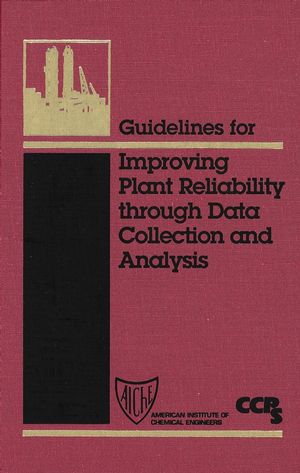Guidelines for Improving Plant Reliability Through Data Collection and AnalysisISBN: 978-0-8169-0751-9
Hardcover
208 pages
June 1998
 This is a Print-on-Demand title. It will be printed specifically to fill your order. Please allow an additional 10-15 days delivery time. The book is not returnable.
|
||||||
Acknowledgments.
Chapter 1. Introduction.
1.1. Background.
1.2. Taxonomy.
1.3. Data Aggregation/Sharing.
Chapter 2. Definitions.
2.1. Introduction.
2.2. Discussion of Key Reliability Terms.
2.3. Glossary of Terms.
Chapter 3. Method of Analysis.
3.1. Introduction.
3.2. Basic Concepts of Data Analysis.
3.2.1. Failure Data.
3.2.2. Need for Correct Failure Modes.
3.2.3. Types of Systems-Repairable or Nonrepairable.
3.2.4. Reliability versus Availability.
3.2.5. Types of Data-Censoring.
3.2.6. Definitions.
3.2.7. Dealing with Censored Data.
3.2.8. Common Cause Failures.
3.2.9. Predictive versus Descriptive Methods.
3.3. Data Manipulation Examples.
3.3.1. Methods of Analysis.
3.4. Cyclical Service.
3.5. Batch Service.
3.6. Standby Service.
3.7. Failures Following a Repair.
3.8. Selecting an Operating Mode.
3.9. Analysis Based on Statistical Inferences.
3.9.1. Modeling Reliability Parameters for the Population.
3.9.2. The Weibull Distribution.
3.9.3. Graphical Method for Estimating the Weibull Parameters.
3.9.4. The Exponential Distribution.
3.9.5. Confidence Limits for Reliability Parameters.
References.
Chapter 4. Example Applications.
4.1. Introduction.
4.2. Conducting a Reliability Analysis-Pump Example.
4.3. Right-Censoring.
4.4. MTTF by Numerical Integration.
4.5. Reliability Calculations for Repaired Items.
4.6. Calculation of MTTR by Numerical Integration.
4.7. Fitting a Weibull Distribution.
4.8. Combinations of Failure Distributions.
4.9. System Performance-Compressor Example.
4.10. Life-Cycle Costs-Compressor example (continued).
4.11. Maintenance Budgeting-Compressor Example (continued).
4.12. Throughput Targets-Compressor Example(continued).
4.13. Summary.
References.
Chapter 5. Data Structure.
5.1. Data Structure Overview.
5.2. General Taxonomy.
5.2.1. Taxonomy Levels 1-4 (Industry, Site, Plant, Process Units).
5.2.2. Taxonomy Levels 5-7 (System, Component, Part).
5.2.3. Treatment of Subordinate Systems in the CCPS Database.
5.3. Database Structure.
5.3.1. Inventory Tables.
5.3.2. Event Tables.
5.3.3. Failure Logic Data.
Chapter 6. Quality Assurance of Data.
6.1. Introduction.
6.2. Basic Principles of Quality as Applied to Equipment Reliability Data.
6.3. Quality Management.
6.4. Quality Principles.
6.5. Verification of Data Quality.
6.5.1. Quality Plan for Database Administrator (DA).
6.5.2. Quality Plan for Data Subscribers.
6.5.3. Certification of Data Subscribers.
6.5.4. Internal Verification of Data Quality.
6.5.5. Verification of Data Prior to Acceptance.
6.5.6. Recertification of Data Contributors.
6.5.7. Appeal Process.
6.5.8. Audits of Work Process.
Appendix I. Guidelines for Data Collection and Submission.
I.1. Introduction.
I.1.1. Data Types.
I.1.2. Subscriber Data.
I.1.3. Inventory Data.
I.1.4. Event Data.
I.1.5. Data Analysis.
I.1.6. Database Limitations.
I.1.7. Goals of the Equipment Reliability Process.
I.1.8. Certification of a Subscriber.
I.2. Data Definitions and Descriptions.
I.2.1. Introduction.
I.2.2. Inventory Descriptions and Data Sheets.
I.2.3. Event Descriptions and Data Sheets.
I.3. Data Flow.
I.4. Internal Quality Assurance of Data.
I.4.1. Data Input Organization.
I.4.2. Quality Plan.
I.4.3. deviation Reporting.
I.5. Data Submission Procedure.
I.5.1. User Software Requirements.
I.5.2. Data Submission Protocol.
I.5.3. Format of Data Submission.
I.5.4. Availability of New Data.
I.6. External Quality Assurance of Data.
I.6.1. Field Verification.
I.6.2. Spot Checks.
I.6.3. Receipt and Logging.
I.6.4. Validation.
I.6.5. Procedures for Nonconformities.
I.7. Data Contribution and Data Distribution.
I.7.1. Data Contribution.
I.7.2. Data Distribution.
Appendix II. Sample Pick Lists for Data Fields.
II.1. Pick Lists Related to Upper Level Taxonomy.
II.2. Pick Lists Related to Plant Inventory and Events.
II.3. Pick Lists Related to General Equipment Information.
II.4. Pick Lists Related to Relief Devices.
II.5. Tables Related to Compressors.
II.6. Pick Lists Relate to Heat Exchangers.
Appendix III. Procedure for Developing System-Level Taxonomies.
III.1. Background and Theory.
III.1.1. Objective.
III.1.2. Overview of the Taxonomy Development Process.
III.2. Procedure.
III.2.1. Define the System.
III.2.2. Analyze Functional Characteristics.
III.2.3. Specify the Inventory Data.
III.2.4. Specify the Event Data.
References.
Index.



